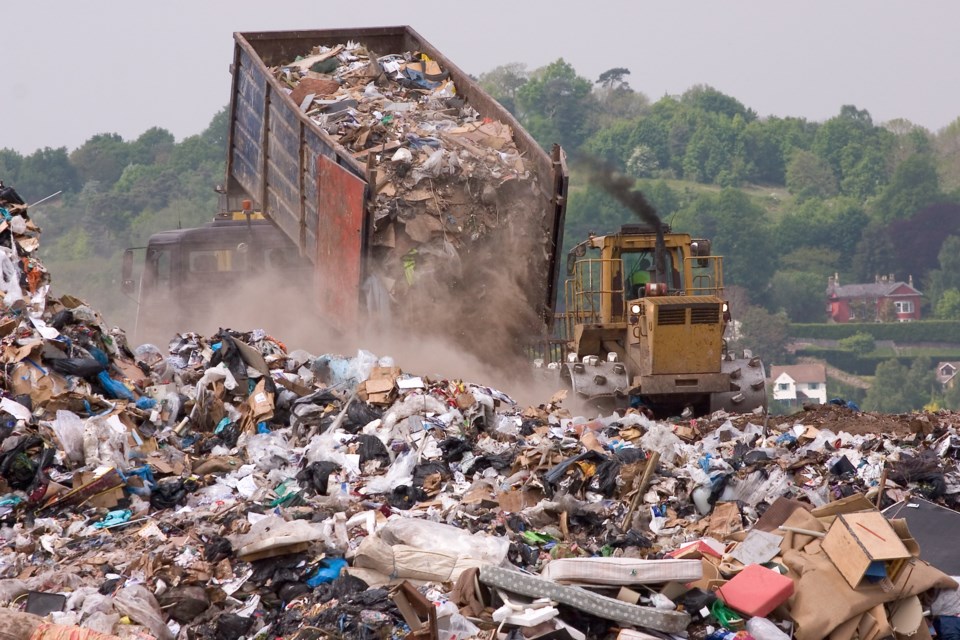With the clock ticking, there’s about a year remaining before the Collingwood landfill will close for good.
According to current estimates from the County of Simcoe, the Collingwood landfill has 59,372 cubic metres of capacity remaining, with the landfill expected to close sometime in 2023.
Director of Solid Waste Management Rob McCullough told CollingwoodToday.ca this week that the Collingwood site will still be used as a transfer station after the landfill portion is closed.
“From the public’s point of view of using the site...instead of garbage being dropped off at the garbage pad and carried to the back of the site, the garbage will be dropped off at the garbage pad and will be loaded onto a truck to be transported out of the county,” said McCullough.
In Simcoe County, garbage marked for export currently goes primarily to Walker landfill in Niagara. Exported recycling is processed at Green for Life in Toronto, and organics are sent to BioEn in Elmira.
According to 2021 County of Simcoe budget estimates, the county pays about $13 million annually for the export, processing, and disposal of wastes. That figure does not include revenue gained through the provincial recycling program as it varies annually.
The process for closing a landfill includes adding about 1,000 millimetres of clay on top of the landfill, then adding topsoil and grass. The Collingwood landfill site specifically is used for the dumping of “dry waste,” which includes items such as couches or chairs collected via drop off as opposed to curbside.
“Those materials were collected at all eight of our landfill sites and were hauled up to Collingwood,” said McCullough. “For the past eight or 10 years, we’ve shredded that garbage so we can maintain that landfill for as long as possible.”
In 2021, County of Simcoe curbside waste collection crews picked up approximately 98,027 tonnes of waste material (garbage, organics, recyclables, and seasonal collections).
Diversion rates refer to the amount of waste diverted from the landfill through recycling and organics programs. Diversion rates in Simcoe County increased in 2021 to 63.7 per cent to 62.5 per cent in 2020. The county ranked second in all of Ontario for diversion rates last year.
“We’re really impressed with our Simcoe County residents,” he said. “We continue to be in a good spot.”
Since the start of biweekly collection in 2020, curbside organic tonnages have continued to increase, from 35.9 per cent prior to the change in 2020 to 61.4 per cent now. Despite the large increase in organics capture, the organics contamination rate decreased substantially, meaning the material is much cleaner.
Curbside organics increased by 2,685 tonnes (13.4%) over 2020. Curbside garbage was similar to the previous year with only 49 more tonnes collected in 2021. Curbside recycling increased by 1,674 tonnes (6.6%) in 2021 compared to 2020.
McCullough notes that per-person, production of waste actually went down in 2021, however the increase in population has led to a net overall increase.
He said it was “a bit of a shock” seeing the 2021 census numbers released this week, showing an increase in populations across Simcoe County in 2021 over 2016. In Collingwood, there was a 13.8 per cent increase in population from 21,793 people in 2016 to 24,811 people in 2021.
“Until we saw the census, we didn’t understand clearly where that was coming from. We had wondered if it was an increase in consumerism,” he said. “It was an interesting development.”
McCullough says he has Simcoe County capacity concerns moving forward, as landfills across the province shutter and municipalities across the board are having to explore more export options.
In January 2021, a report commissioned by the Ontario Waste Management Association found that based on the current landfill capacity depletion rate, Ontario’s available landfill capacity is expected to be exhausted by 2032. If the United States were to prohibit Ontario waste from crossing the border, Ontario’s landfill capacity will be exhausted by 2028.
Based on forecasted tonnages and population growth, the other two landfill sites in Simcoe County are also slated to close within that time frame. The Nottawasaga landfill is currently sitting at 42,160 cubic metres of capacity remaining, and is expected to reach capacity in 2025, while the Oro-Medonte landfill has 247,329 cubic metres of capacity remaining and will reach capacity in 2029.
Looking to the future, the county is in the midst of planning an update to its Solid Waste Management Strategy which was originally approved by council in 2010 and mapped out plans for 20 years. The update is expected to be delivered with recommendations to County of Simcoe council this fall.
As part of that update, the county will be rolling out a public survey to gather input from county residents on what they think about what direction the county should be taking when it comes to waste management.
McCullough said the update was planned to come earlier this year, but was delayed due to major changes within waste collection.
“We’ve had so many changes which are partially due to the pandemic, but are also due to our new automated cart collection contract,” he said.
The survey is planned to be released to the public by June and will be open for six weeks.



